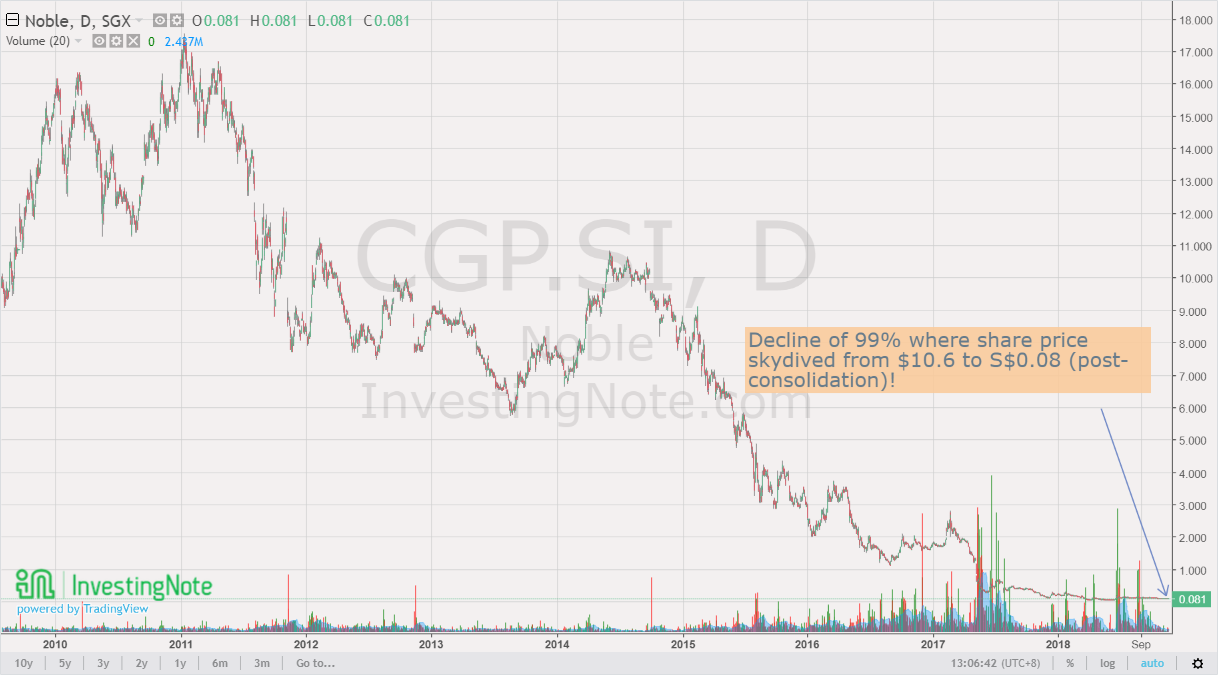If the recent demise of Noble Group rings a bell to you, you are probably in the stock market for at least a few years and heard about all the warning signs of the company.
But have you ever wondered why Noble (SGX: CGP) can go from S$10.60 all the way to S$0.08 and finally gets suspended? I still remember people saying that it is an undervalued screaming buy when it was trading at S$0.20. Hopefully they have got out of their position before the suspension.
On hindsight, there are a few tell-tale warning signs for Noble Group for their demise:
- The management team is destroying shareholder value by paying themselves handsomely at the company’s expenses
- High turnover rate for the top management + independent directors
- Creative accounting at its best – overvaluing all their subsidiaries at sky high valuations when it is worth much lesser
- Flawed business model – Super low net margins with negative operating cash flow for yearssss
Stocks like this can potentially cause a big dent in your portfolio if you are not careful. Thus, it is vital to avoid such stocks and here’s 3 main categories on how to detect warning signs of lousy companies:
1. Past Business Performance
One quick way is to look at a company’s past business performance.
Try taking a full economic cycle of 5-10 years into consideration when looking at a company’s business performance (or at least for the past 3 years). Watch out for the following warning signs:
- Not profitable business (Low Return on Equity)
- Fluctuating Profits over the years (A sign of weak business model and lack of consistency)
- Negative Free Cash Flow (Persistent negative FCF will mean they require capital from borrowings or equity – rights issue)
- Business has too much debt (High Debt-to-Equity ratio)
Read also: https://www.smallcapasia.com/learn-5-golden-rules-master-investors/
2. Evaluate the Business Model
In order to understand a company’s strategy and how it drives profits and losses, it is essential to thoroughly understand the current business model.
Companies exhibiting the following tendencies are potential capital killers:
- Hard to understand or damaged business model (What is exactly the model?)
- New technology (It usually doesn’t pan out well in face of competition)
- On-going turnaround (Talk is cheap, look at the numbers to confirm a turnaround)
- Great story (Similar to above but no profits in sight)
- Consumes capital in the form of rights issues at lower prices than before
- Takes a long time to deliver (Time risk – wait for this company or invest in another one?)
3. Management’s Alignment of Interests
People run businesses and that is what you’re investing in. As an investor, you need to feel 100% comfortable with the business’ strategy, focus and goals.
It’s important to understand what motivates the management. Avoid boards and management teams exhibiting these potentially share-eroding characteristics:
- Strategy not clear (What is the strategy?)
- Untrustworthy management (Did not deliver on previous promises)
- Low/No ownership in the company (No alignment of interests)
- High base salaries and Low Bonuses on achieving targets (Leads to poor motivation to push for growth in the firm)
- Management always wins (No negative repercussions for failing to meet targets)
Conclusion
Remember to carefully look at past business performance, the business model and most importantly board and management motivation to detect warning signs of lousy companies.
While you’re at it, do you want to learn how to invest and compound your wealth steadily with your own system? You’re in luck because we have developed an Unique Investing System just for you via a simple 10-Step Checklist.
Simply click to DIY your one-and-only Investing System today!



